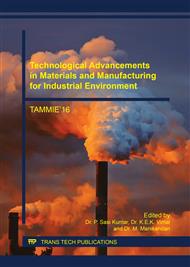[1]
Davim, J. P., Machining of hard materials, Springer-Verlag, London, (2011).
Google Scholar
[2]
Huang Y, Chou YK, Liang SY, CBN tool wear in hard turning: a survey on research progresses, International Journal of Advanced Manufacturing Technology, 35 (2007) 443–453.
DOI: 10.1007/s00170-006-0737-6
Google Scholar
[3]
Aouici H, Yallese MA, Chaoui K, Mabrouki T, Rigal JF. Analysis of surface roughness and cutting force components in hard turning with CBN tool: prediction model and cutting conditions optimization, Measurement, 45 (2012) 344–353.
DOI: 10.1016/j.measurement.2011.11.011
Google Scholar
[4]
Jeffrey D. Thiele, Shreyes N. Melkote, Effect of cutting edge geometry and work piece hardness on surface generation in the finish hard turning of AISI 52100 steel, Journal of Materials Processing Technology, 94 (1999) 216-226.
DOI: 10.1016/s0924-0136(99)00111-9
Google Scholar
[5]
Anderson P. Paiva, João Roberto Ferreira , Pedro P. Balestrassi, A multivariate hybrid approach applied to AISI 52100 hardened steel turning optimization, Journal of Materials Processing Technology, 189 ( 2007) 26–35.
DOI: 10.1016/j.jmatprotec.2006.12.047
Google Scholar
[6]
Mohamed Walid Azizi, Salim Belhadi, Mohamed Athmane Yallese, Tarek Mabrouki and Jean-François Rigal, Surface roughness and cutting forces modeling for optimization of machining condition in finish hard turning of AISI 52100 steel, Journal of Mechanical Science and Technology, 26 (12) (2012).
DOI: 10.1007/s12206-012-0885-6
Google Scholar
[7]
Y. Kevin Chou, Hui Song, Tool nose radius effects on finish hard turning, Journal of Materials Processing Technology, 148 (2004) 259–268.
DOI: 10.1016/j.jmatprotec.2003.10.029
Google Scholar
[8]
Nexhat Qehaja, Kaltrine Jakupi, Avdyl Bunjaku, Mirlind Bruçi, Hysni Osmani, Effect of Machining Parameters and Machining Time on Surface Roughness in Dry Turning Process, Procedia Engineering, 100 (2015) 135–140.
DOI: 10.1016/j.proeng.2015.01.351
Google Scholar
[9]
C. J. Rao, D. Nageswara Rao, P. Srihari, Influence of cutting parameters on cutting force and surface finish in turning operation, Procedia Engineering, 64 (2013) 1405–1415.
DOI: 10.1016/j.proeng.2013.09.222
Google Scholar
[10]
Lin, Z. C., Chen, D. Y., A study of cutting with a CBN tool, Journal of Materials Processing Technology, 49 (1995) 149-164.
Google Scholar
[11]
Chen W., Cutting forces and surface finish when machining medium hardness steel using CBN tools, International Journal of Machine Tools and Manufacture, 40 (2000) 455-466.
DOI: 10.1016/s0890-6955(99)00011-5
Google Scholar
[12]
J. Guddat, R. M'Saoubi, P. Alm, D. Meyer Hard turning of AISI 52100 using PCBN wiper geometry inserts and the resulting surface integrity, Procedia Engineering 19 (2011) 118 – 124.
DOI: 10.1016/j.proeng.2011.11.089
Google Scholar


